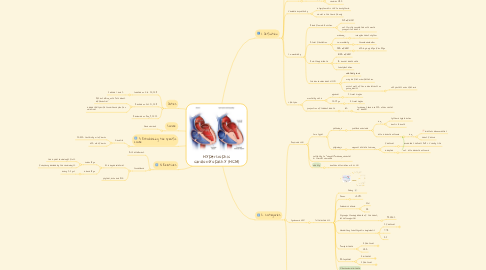
1. Dates
1.1. Created on Oct 30, 2019
1.1.1. Finished 1. and 2.
1.2. Revised on Oct 31, 2019
1.2.1. After talking with Josh about differential
1.2.2. added UHN specific surveillance plan for relatives
1.3. Reviewed on Aug 9, 2023
2. Source
2.1. Gene reviews
3. 3. Establishing the specific cause
3.1. Genetics
3.1.1. 30-40% sensitivity w/o famhx
3.1.2. 60% with famhx
4. 4. Relatives
4.1. Risk assessment
4.2. Surveillance
4.2.1. 1st degree relatvies
4.2.1.1. under 18 yo
4.2.1.1.1. see a peds cardiologist first
4.2.1.1.2. frequency decided by the cardiologist
4.2.1.2. above 18 yo
4.2.1.2.1. every 3-5 yrs
4.2.2. physical, echo and ECG
5. 1. Definition
5.1. Definition: max LV wall thickness
5.1.1. without anything else
5.1.1.1. adult
5.1.1.1.1. >=15mm
5.1.1.2. children
5.1.1.2.1. z-score > 3
5.1.2. with famhx or genotype +
5.1.2.1. >=13mm
5.1.3. need to R/O
5.1.3.1. ventricular dilatation
5.1.3.2. confounding factors causing hypertrophy
5.1.3.2.1. e.g. pressure overloaad
5.1.3.2.2. e.g. storage/infiltrative disorders
5.2. Detection
5.2.1. heart imaging
5.2.1.1. echocardiography
5.2.1.2. cardiac MRI
5.3. Variable expressivity
5.3.1. asymptomatic LHV to arrhythmia
5.3.2. varies in the same family
5.4. Co-morbidity
5.4.1. Blood flow obstruction
5.4.1.1. 2/3 of HCM
5.4.1.2. not strictly correlated with worse prognosis or death
5.4.2. Atrial fibrillation
5.4.2.1. meaning..
5.4.2.1.1. irregular heart rhythm
5.4.2.2. co-morbidity
5.4.2.2.1. thromboembolism
5.4.2.3. 20% of HCM
5.4.2.3.1. 60% by age 60yo if dx.40yo
5.4.3. End-stage disease
5.4.3.1. 5-10% of HCM
5.4.3.2. 11% annual death rate
5.4.3.3. transplantation
5.4.4. Sudden cardiac death (SCD)
5.4.4.1. relatively rare
5.4.4.2. may be first manifestation
5.4.4.3. occurs most often in adolescents or young adults
5.4.4.3.1. risk persists over lifetime
5.5. Life-span
5.5.1. mortality rate
5.5.1.1. general
5.5.1.1.1. 3 times higher
5.5.1.2. 20-29 yo
5.5.1.2.1. 4 times higher
5.5.2. proportion of suddent death
5.5.2.1. 16%
5.5.2.1.1. (meaning there are 50% other causes of death)
6. 2. Categories
6.1. Acquired LVH
6.1.1. two types
6.1.1.1. pathologic
6.1.1.1.1. pressure overload
6.1.1.2. physiologic
6.1.1.2.1. rigorous athletic training
6.1.2. possibility to "regress"(meaning reverse) w stimulus removed
6.1.3. obesity
6.1.3.1. another association with LVH
6.2. Syndromic HCM
6.2.1. 7+1 selected list
6.2.1.1. Fabry
6.2.1.2. Danon
6.2.1.2.1. LAMP2
6.2.1.3. Friedreich ataxia
6.2.1.3.1. FXN
6.2.1.3.2. AR
6.2.1.4. Glycogen storage disease of the heart, lethal congenital
6.2.1.4.1. PRKAG2
6.2.1.5. Hereditary transthyretin amyloidosis
6.2.1.5.1. 3 features
6.2.1.5.2. TTR
6.2.1.5.3. AD
6.2.1.6. Pompe disease
6.2.1.6.1. 4 features
6.2.1.6.2. GAA
6.2.1.7. RASopathies
6.2.1.7.1. 4 diseases
6.2.1.7.2. 5 features
6.2.1.8. Mitochondrial disease
6.3. Non-syndromic HCM
6.3.1. genetic testing sensitivity
6.3.1.1. w/ famHx
6.3.1.1.1. 50-60%
6.3.1.2. w/o famHx
6.3.1.2.1. 20-30%
6.3.2. double hit rate
6.3.2.1. 3-5%
6.3.2.1.1. biallelic or heterozygous
6.3.2.1.2. <1%
6.3.3. inheritance
6.3.3.1. mostly
6.3.3.1.1. AD
6.3.3.2. others
6.3.3.2.1. AR
6.3.3.2.2. Digenic
